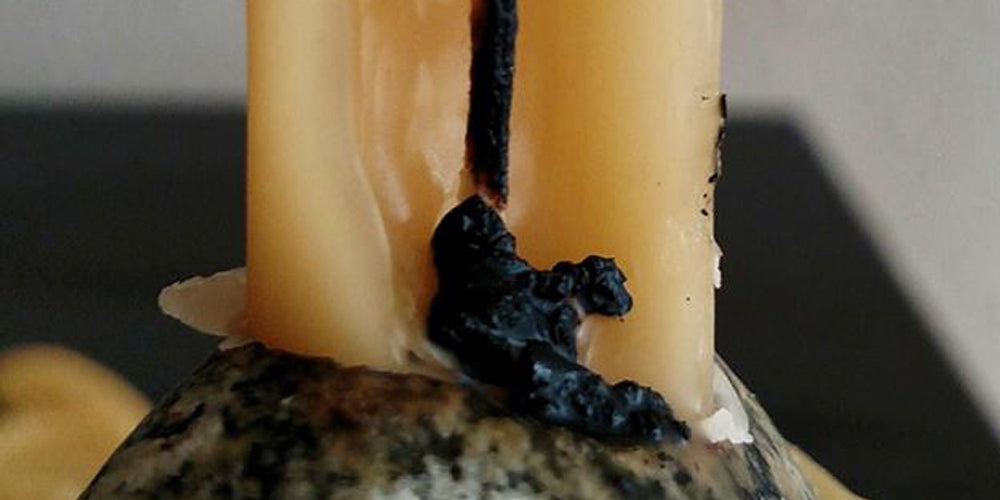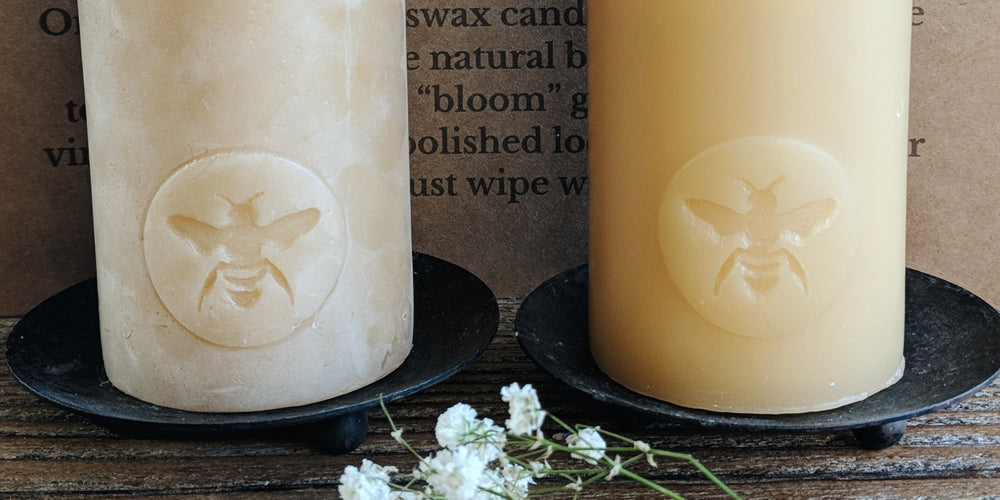As candle makers, the thing we always work to eliminate are those pesky, ugly carbon balls that form on the tip of a candle's wick. They are so common that most candle burners just take them for granted. They form on every type of candle, container, votive, pillars and tapers. They are even more prone to form if the candle has added fragrance or coloring. If it's a candle, it can form a carbon ball.
Candle makers dislike carbon balls (also known as carbon caps or mushrooming) not because they are ugly globs of burnt carbon, but because they can ruin a beautiful candle if the customer isn't watching for the signs.
A carbon ball can form for many reasons, so instead of giving you a boring lecture on why they form, I'll share some tips on how you can head them off at the pass and stop those little black balls from ruining your lovely candle.
 The first thing I do if I see a large carbon ball forming is to take a metal wick dunker or something made of metal and bend the wick so that the tip curls into the side of the flame (where it is hotter). The carbon ball could be forming because the wick is standing straight up and not curled into the hottest part of the flame (which is on the side of the flame). Most wicks are designed to curl slightly so if a wick is pointing straight up and forming a carbon ball, help it out by bending the tip slightly to the side of the flame. You will see the carbon ball get burned up and then the wick should behave properly after the carbon ball burns away.
The first thing I do if I see a large carbon ball forming is to take a metal wick dunker or something made of metal and bend the wick so that the tip curls into the side of the flame (where it is hotter). The carbon ball could be forming because the wick is standing straight up and not curled into the hottest part of the flame (which is on the side of the flame). Most wicks are designed to curl slightly so if a wick is pointing straight up and forming a carbon ball, help it out by bending the tip slightly to the side of the flame. You will see the carbon ball get burned up and then the wick should behave properly after the carbon ball burns away.
Sometimes carbon balls still form even if the wick is slightly curled because there is a lot of added fragrance or coloring in the wax. Or sometimes, it's not the best wick for that candle. All experienced and reputable candle makers will test, test, and test their candles to make sure they have found the best wick for their wax and fragrance combination, but sometimes, a candle still ends up with an underperforming wick and the only thing you can do about it is babysit your candle and cut off any carbon balls that are forming.
 Aside from making the candle look unattractive, a large carbon ball can break off the tip of the wick and fall onto the side of the candle. When that happens, you have two flames burning at one time. The rogue carbon ball can land on the side of the candle and burn a hole right through the candle. The flame on top will eventually get to that hole and will drop down all the way to the bottom of the candle. The entire candle can turn into a puddle of wax and if both flames are still active, can turn into one large flame. That is why you should always, always use a fireproof candle plate for any candle you burn. If it's a container candle, the carbon ball can fall into the melt pool and continue burning and cause a secondary flame.
Aside from making the candle look unattractive, a large carbon ball can break off the tip of the wick and fall onto the side of the candle. When that happens, you have two flames burning at one time. The rogue carbon ball can land on the side of the candle and burn a hole right through the candle. The flame on top will eventually get to that hole and will drop down all the way to the bottom of the candle. The entire candle can turn into a puddle of wax and if both flames are still active, can turn into one large flame. That is why you should always, always use a fireproof candle plate for any candle you burn. If it's a container candle, the carbon ball can fall into the melt pool and continue burning and cause a secondary flame.
You pay good money for quality candles and the last thing you want to see is your sweet candle getting ruined by a rogue carbon ball.
How to slay a Rogue Carbon Ball:
- If the wick is sticking straight up and forming a large carbon ball, take a metal object and gently curve the tip of the wick into the side of the flame (where it burns hotter). Leave the wick in the gently curved position to prevent new carbon balls from forming.
- If the wick still forms carbon balls regardless of its position, then you will have to babysit that bad boy and frequently trim the carbon ball off and remove it from the candle.
Thank you for taking time to read our blog!
Bee Cozy


